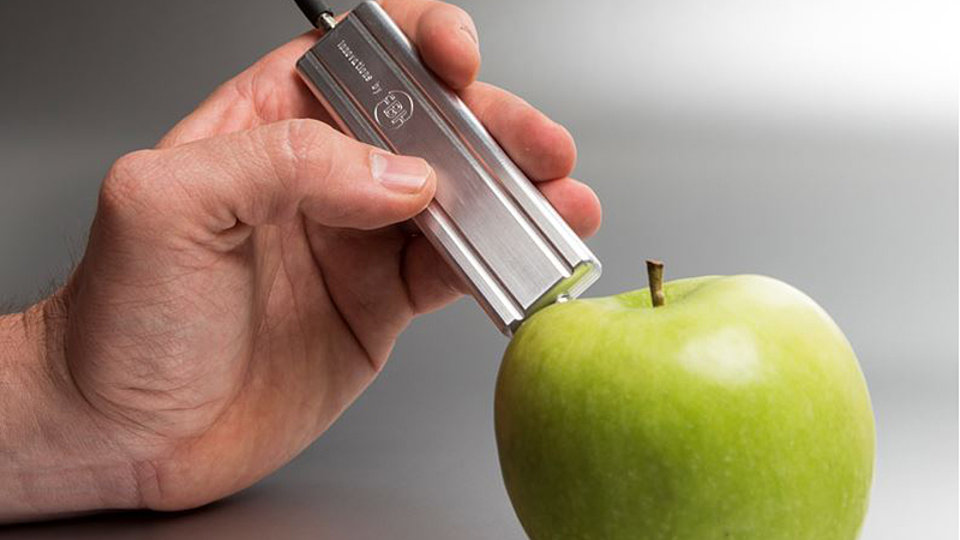Handheld Raman probe with implemented dual-wavelength diode laser at 785 nm for in situ SERDS
Fig. 1: Optical spectra of the implemented dual-wavelength diode laser at 785 nm at an excitation power of 50 mW
Raman spectroscopy is an established and powerful optical measurement technique for the analysis of various organic and inorganic samples. To accomplish in situ measurements, portable Raman systems become increasingly attractive. Because of their small size and low power consumption semiconductor diode lasers are preferred for integration and thus used as excitation light sources.
However, for outdoor measurements the weak Raman signals are often obscured by disturbing signals. This background interference can be caused by either sample fluorescence or impurities and ambient light. Shifted Excitation Raman Difference Spectroscopy (SERDS) has been successively demonstrated as an easy-to-use spectroscopic tool to separate the Raman signals from background interference. For this purpose, two Raman spectra are generated with slightly different excitation wavelengths. Between both measurements all other measurement parameters including the spectral calibration of the spectrometer are unchanged. The spectral distance between both laser lines should be in the range of the linewidth of typical Raman lines under investigation and thus 10 cm-1 for most solid and liquid samples. The spectral shift of the excitation wavelength leads to a shift of the generated Raman lines but has nearly no effect on the disturbing signals such as fluorescence and ambient light. After the measurement, both Raman spectra are subtracted and show a difference spectrum. This way, the Raman signals are clearly separated from background interference.
A dual-wavelength diode laser emitting at 785 nm was developed at the FBH as an excitation light source for SERDS, and its application has been successfully demonstrated. The monolithic light source shows optical output powers up to 140 mW with a power consumption of 0.7 W, exhibiting a stable single-mode operation with a spectral width ≤ 11 pm over the whole power range (Fig. 1).
Recently, the FBH developed a novel Raman probe (Fig. 2) using such a compact and efficient diode laser as integrated excitation light source. Here, the laser light is directed via optical filters and mirrors to the sample under investigation – an apple in this case. The 180° backscattered light is collected by the probe. Optical filters then separate the Raman photons from the laser light. The Raman probe is connected to a spectrometer via an optical fiber. Experiments demonstrate the suitability of the probe for Raman investigations. Here, the Raman spectra show a spectral stability within 0.1 cm-1 over one hour measurement time. With a stability of ± 2% the intensity variations in the Raman signals are mainly caused by shot-noise interference. The experimental results validate the suitability of the compact probe for Raman investigations, enabling this handheld device to be used for in situ SERDS measurements in application fields such as food safety control, medical diagnostic, and process monitoring.
Publications
B. Sumpf, M. Maiwald, A. Müller, J. Fricke, P. Ressel, F. Bugge, G. Erbert and G. Tränkle, "Comparison of two concepts for dual-wavelength DBR ridge waveguide diode lasers at 785 nm suitable for shifted excitation Raman difference spectroscopy", Appl. Phys. B, vol. 120, no. 2, pp. 261-269 (2015).
M. Maiwald, B. Eppich, J. Fricke, A. Ginolas, F. Bugge, B. Sumpf, G. Erbert, G. Tränkle, "Dual-Wavelength Y-Branch Distributed Bragg Reflector Diode Laser at 785 Nanometers for Shifted Excitation Raman Difference Spectroscopy", Appl. Spectrosc., vol. 68, no. 8, pp. 838-843 (2014).
M. Maiwald, B. Eppich, A. Ginolas, B. Sumpf, G. Erbert, G. Tränkle, "Compact handheld probe for Shifted Excitation Raman Difference Spectroscopy with implemented dual-wavelength diode laser at 785 nm", Appl. Spec., in production and scheduled for October 69[10] (2015).

